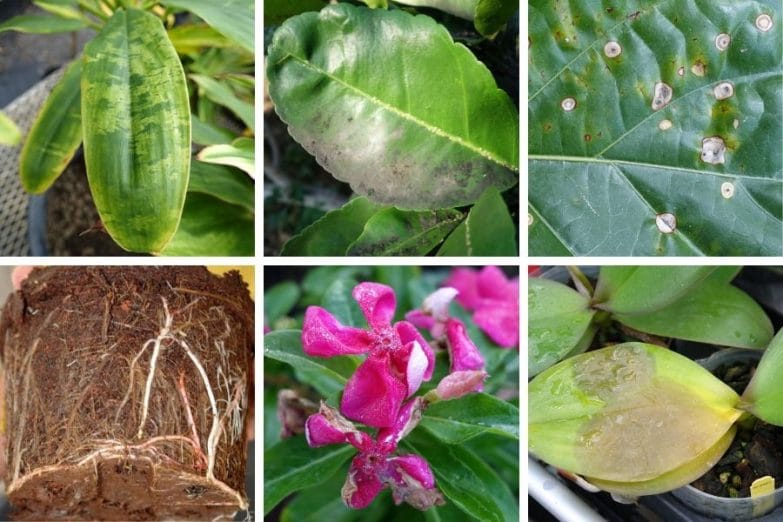The last thing you want to see is your previously healthy houseplant showing signs of disease. With all the possible causes, identifying and treating the problem can seem daunting. However, don’t stress, because this article will cover how to recognize common houseplant diseases as well as what you can do regarding treatment and prevention.
Common Houseplant Diseases: Houseplants can be afflicted with many different bacterial, fungal and viral diseases. Identification can often be done through inspection of the plant and the growing conditions. Being able to identify the disease helps you to treat your plant correctly and take steps to prevent further problems.
Read on to learn everything you need to know about common houseplant diseases and how to identify, treat and prevent them, to keep your houseplants thriving.
Root Rot/Stem Rot
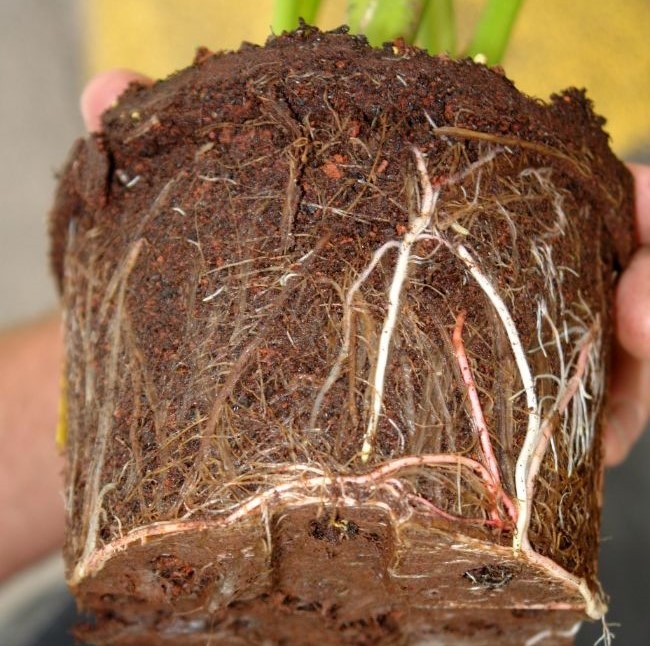
The cause for root and stem rot in the vast majority of houseplants is persistent overwatering or poorly draining soil. As overwatering is such a common issue, this makes root and stem rot one of the most common houseplant diseases.
Cause
Root and stem rot is caused by a variety of fungal organisms, with Fusarium, Pythium, Rhizoctonia, Phytophthora being the most common. The fungal pathogens thrive in soils that drain poorly and remain wet, as well as the potting mix, infecting the root system of plants that are stressed and weak
Symptoms
Symptoms of root and stem rot include the infected plant wilting from bottom to top even though the soil is wet, as well as foliage and stems turning brown, yellow or black. Additionally, the roots will be mushy and brown or black, instead of a healthy white. There may also be a rotten smell from the roots or affected parts of the plant.
Prevention And Treatment
Unless you are able to root unaffected cuttings from the affected plant, sometimes the best course of action is to throw the plant with root rot away and start anew. Often, by the time the plant shows symptoms of the disease, the root system is infected and cannot be saved.
However, if you want to try to save the plant you can follow the advice in this article to try to nurse your plant back to health.
Prevention is key to eliminating root and stem rot in your houseplants.
- Only purchase healthy plants.
- Use clean containers with bottom drainage.
- Don’t reuse potting mixes.
- Use a potting mix that has good drainage.
- Water only when the plant needs it and don’t keep the soil soggy.
- Reduce watering in winter while your plant has ceased actively growing.
Fungal Leaf Spots
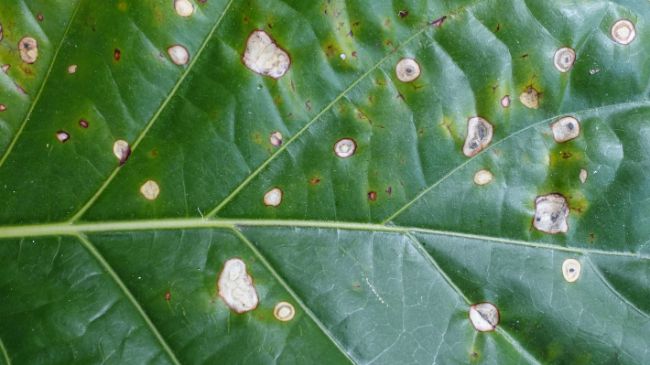
Various types of fungi cause fungal leaf spots on houseplants. Fortunately, and regardless of the fungi type, identifying a fungal leaf spot problem, as well as preventing and treating the problem are the same.
Cause
The fungi that create fungal leaf spots on your houseplants and can infect the potting mix are most prevalent when conditions are cool and wet. This is especially true when the potting mix is consistently wet and the plant’s foliage remains wet for long periods, especially at night. The fungi also inhabit and survive on fallen plant debris.
Symptoms
It goes to reason that fungal leaf spots show up as spots on the houseplant’s foliage and range in colors of brown, black, reddish, yellow or tan. The spots can grow together resulting in leaf drop and distortion.
Prevention And Treatment
If you notice a houseplant developing fungal leaf spots, remove any affected leaves and fallen debris laying on top of the soil where the fungi thrive. In severe infections, you can treat with a fungicidal spray safe for your particular plant that kills the infecting fungi.
Prevent future fungal leaf spot problems by:
- Decreasing the amount of humidity around the houseplant.
- Water early in the day so it has time to dry by nightfall.
- Don’t splash water on the foliage.
- Increase air circulation.
- Keep the top of the potting mix clean by removing fallen plant debris.
- Don’t reuse infected potting mixes.
Bacterial Leaf Spot
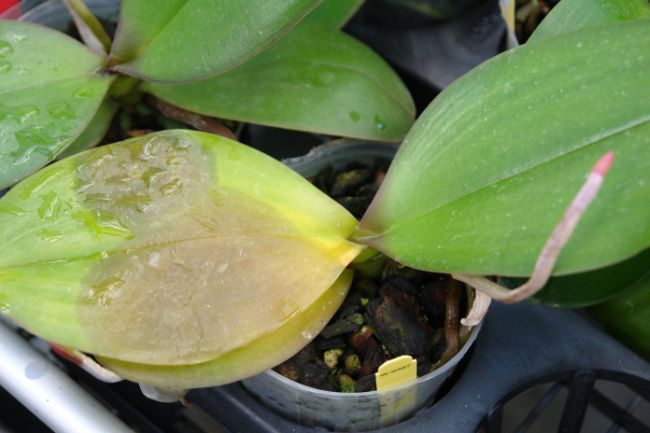
Bacterial leaf spot problems in houseplants can be serious and depending on the type, can result in plant death. There are various bacteria types causing the problem and the disease either remains localized, for example, only affecting foliage, or becomes systemic and more serious, traveling throughout the stems and leaves.
Cause
Bacteria causing bacterial leaf spots on houseplants thrive in especially cool and wet conditions. Additionally, improper watering practices and overcrowding, also promotes the problem. It’s also possible to infect a healthy plant by reusing soil that contained the leaf-spotting bacteria.
Symptoms
Bacteria leaf spots show up on foliage by forming black, water-soaked areas that sometimes can have a yellow circular pattern around them. As the disease spreads, the water-soaked areas merge, covering large leaf sections.
If the leaf spots are contained only on the foliage, remaining localized and not transferring to the stems too, the plant most likely can be saved.
However, if the black, water-soaked areas cover the stems as well as the foliage and affected areas are mushy and eventually collapse, the bacteria is systemic and affecting the entire plant, which is a more serious problem.
Prevention And Treatment
If the bacterial leaf spots affect the entire plant and are systemic, the only thing you can do is discard the entire plant, as well as the soil in which it was growing. There’s no cure for the problem and it’s best to discard the used soil and not take the chance of infecting a new healthy plant.
If only a few leaves were infected and the bacteria remained localized, you can trim those off the plant and discard. Additionally, you can prevent further bacterial leaf spot problems by:
- Space your houseplants so there’s good air circulation around it.
- Decrease the humidity.
- Water early in the morning so the foliage has time to dry by nightfall.
- Don’t splash water on the foliage.
- Keep the top of the soil clean of fallen plant debris.
- Don’t reuse previously infected soil.
Sooty Mold
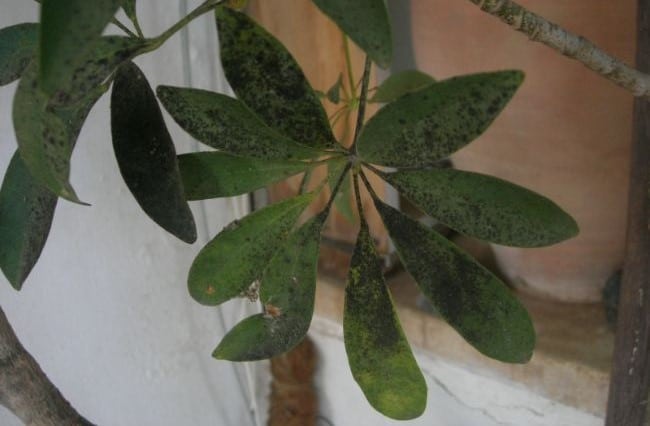
Although you will most likely encounter black sooty mold outdoors in the landscape, under the right conditions the fungi can also infect your houseplants. Finding sooty mold on your houseplants generally means you have a bigger problem than the black substance covering the leaves – pests.
Cause
Several fungi are responsible for creating black sooty mold and although they don’t live off the affected plant, they do thrive on honeydew secreted by several common pests. Pests that create honeydew include:
- Aphids
- Mealybugs
- Soft Scales
- Whiteflies
- Leafhoppers
- Psyllids
In most cases and unless severe, the sooty mold is only an eye-sore and won’t damage the plant unless so much of the leaf surface is covered it’s blocking sunlight. However, the pest attracting the fungi can be another story when it comes to causing damage or eventual plant death.
Prevention And Treatment
To prevent a sooty mold problem from occurring you must first get rid of the pest causing the problem. Since pests like aphids come in a host of colors and are easily camouflaged, it’s best to check your houseplants weekly for signs of a pest problem. This will assure early treatment before the problem springs out of control, leading to sooty mold.
Depending on the particular plant, many times products like neem, insecticidal soap or horticultural oil eliminates the pest problem. However, always follow label directions on use.
To remove the unsightly black mold from the leaves, you can snip the affected ones off the plant with clean tools or wash it off. Gently wiping the affected leaves with a damp cloth usually does the trick of removing the blackness.
Powdery Mildew
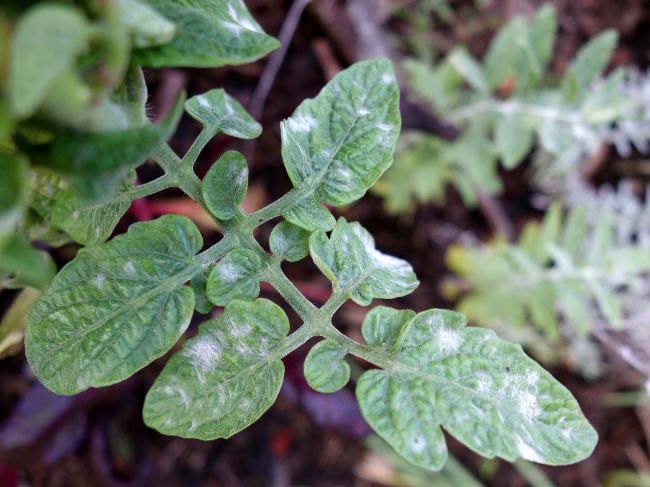
Powdery mildew is a fungal disease that is most prevalent on houseplants during the winter months when indoor temperatures are cooler and humidity is high. The disease usually doesn’t kill the houseplant and controlling the cultural conditions is usually enough to prevent and control the problem.
Cause
Several fungal species of Oidium are the culprits when it comes to your houseplants becoming infected with powdery mildew. Prime conditions for an outbreak are indoor temperatures of 70°F and lower, as well as overcrowding, wet foliage and consistently wet soil along with fallen plant debris remaining in the container.
Fortunately, powdery mildew is much less serious than some other common houseplant diseases and is rarely life-threatening. In a severe outbreak of the disease, the fungal spores can travel through the air and infect your other plants.
Symptoms
Powdery mildew is an easy disease to identify as it shows up on the plant’s foliage as white, powdery-like circles, which can enlarge and merge. Foliage infected with the disease can become distorted and leaf drop can occur.
Prevention And Treatment
If you have an outbreak of powdery mildew on your houseplants, making several cultural changes should have your plants back to prime health in no time at all.
- Remove and discard any affected foliage.
- Clean the soil of any dropped plant debris.
- Decrease humidity.
- Water only when necessary so the soil isn’t constantly wet.
- Water or mist early in the day so the foliage has time to dry by nightfall.
- Allow for good air circulation around the plant.
Gray Mold/Botrytis Blight
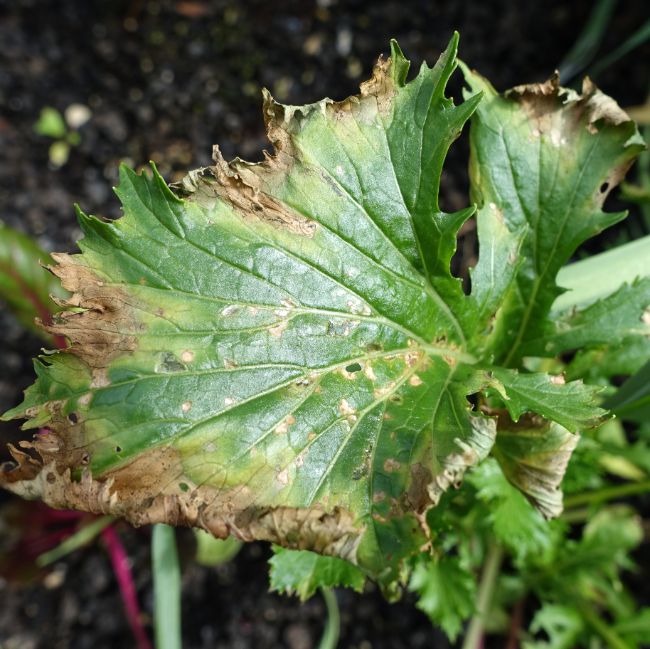
Gray mold, also known as Botrytis blight is one of the common houseplant diseases caused by fungi. It is often a serious problem than can kill the infected plant, especially if conditions are ideal for the pathogen to thrive.
Cause
The fungus responsible for causing gray mold is Botrytis cinerea, which survives on dead plant debris. Gray fungal spores develop covering the debris and once the infected area dries, the spores are released into the air, which can then infect additional houseplants.
In addition, the spores can be transferred to the foliage through water splashing on the leaves when watering.
Gray mold is especially destructive to flowering plants, as the fungus requires a host to live and will cover the petals feeding off them.
Symptoms
Gray mold can be devastating to blooming plants, causing brown spots on the developing petals that enlarge and kill the entire flower. The disease can cause flowers to die before opening. Plants forming from bulbs like tulips can have the disease traveling from the flowers to the bulbs causing them to decay.
In addition, gray mold causes grayish dead bull’s-eye patterns on older foliage, as well as girdling cankers on the stems. The mold is easily identifiable on dead plant debris as it’s covered in a thick grayish mold.
Prevention And Treatment
If your houseplants are suffering from gray mold there are various changes you can make to the environment to assist in prevention. Quickly treating the infected plant can possibly save it and keep the disease in check so it doesn’t spread to your other houseplants. Note that many preventative measures are similar across lots of common houseplant diseases.
- Remove all the infected areas of the plant cutting back stems several inches into a healthy section. Use sterilized pruning tools to keep from spreading the disease.
- Decrease humidity around the plant.
- Increase air circulation around the plant.
- Water early in the day so the foliage has time to dry before nightfall.
- In severe cases, use a fungicide safe to use on the particular plant.
White Mold
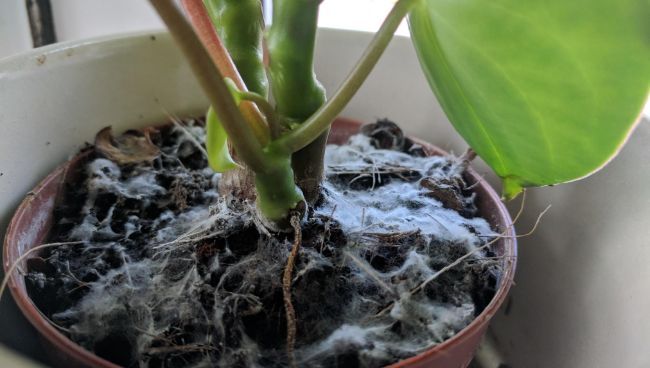
Houseplants that have a white moldy looking substance growing on top of the potting mix aren’t in danger of dying but the fungal mold can make the plant look unsightly. However, it’s an indicator of poor cultural conditions and is easy to correct. Read this article about white mold on houseplants in this article.
Cause
The saprophytic fungus causes the white mold forming on top of your potting mix. Although the fungus won’t kill the plant growing in the soil, the formation of the fungus is a warning sign that growing conditions are lacking and can possibly lead to other more serious disease problems and possibly plant death.
Improper care leads to the saprophytic fungus developing, such as overwatering, growing in previously infected potting mixes and improper drainage due to the container not having drain holes or soil that is too heavy.
Symptoms
Saprophytic fungus is an easily identifiable disease as it leaves a crusty white looking substance covering the top of the potting mix. Unless the plant is infected with another disease, the fungus doesn’t affect the growth or health of the plant.
Prevention And Treatment
If the white mold is making your entire plant look unsightly, you can easily scrape the moldy substance from the top of the soil. However, to prevent future outbreaks of the fungus and another possibly more serious disease infecting the plant you need to correct some of the cultural conditions.
- Allow the soil to dry before applying more water.
- Stop overwatering. A good general rule for watering is applying additional water when the top inch or two of soil becomes dry.
- Use containers that have bottom drain holes so the soil doesn’t remain soggy.
- If reusing a container, make sure to clean it in a bleach solution to kill any bacteria or fungi.
- Grow the plant in fresh potting mix that isn’t heavy and drains well.
Anthracnose
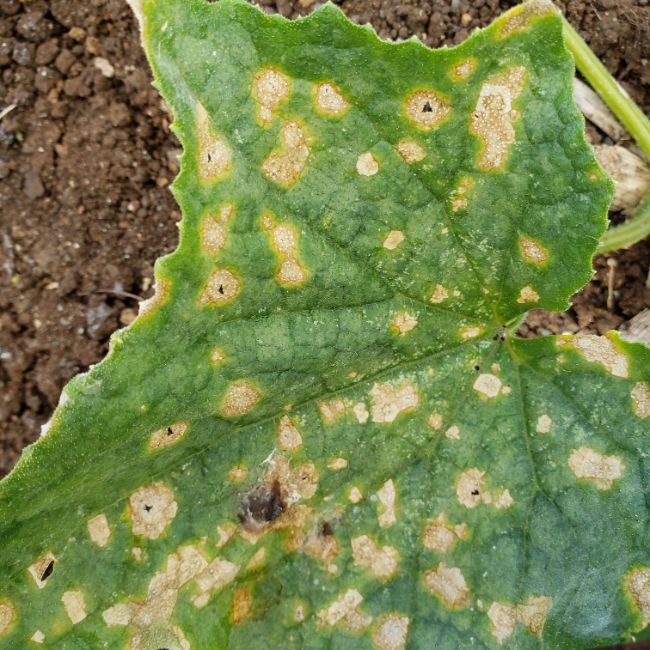
Anthracnose is primarily a soil-born fungal disease affecting houseplants with its main target being ones grown chiefly for their foliage. The spores can also overwinter on leaves and branches, springing to life in warm and humid conditions.
Cause
The fungi Collectrotrichum and Gloeosporium are responsible for anthracnose. The most common cause of infection to your houseplants is by reusing infected soil, allowing dead plant debris to reside on the soil and improper cultural conditions.
Additionally, your plants can become infected with the fungal spores if you allow them to spend some time outdoors or you purchase a plant already infected with the disease.
Fortunately, and unless the disease is severe, most plants will recover from a bout of anthracnose provided you take a few steps in treating the disease and preventing future outbreaks.
Symptoms
The most common sign your plant is dealing with an anthracnose problem is the leaf tips yellowing. The yellow areas darken turning brown and eventually die. Additionally, the discoloration can extend all the way around the leaf’s outer sides.
Prevention And Treatment
If your houseplant is suffering from anthracnose, you should trim off the infected leaves with sterilized pruning tools and discard. Next, treat the plant with a fungicide designed for anthracnose and safe for use on the plant type like copper.
When it comes to preventing future outbreaks of anthracnose, following some basic tips will assure your plants are healthy and fungus-free.
- Purchase healthy-looking plants from reputable dealers.
- Don’t reuse potting mixes and only plant using clean, fresh soil.
- Decrease humidity around the plant.
- Make sure there’s good air circulation around the plant.
- Keep the top of the potting mix free of fallen plant debris.
Viruses
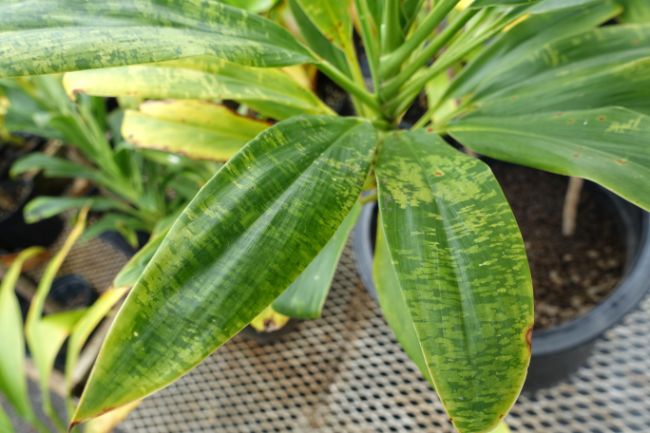
Of all the common houseplant diseases, viruses are the most deadly because there’s no cure. There’s a wealth of different types of viruses that can infect a houseplant and in some cases, more than one can infect the plant.
Cause
All types of plant viruses infect plants in several ways. Plants can be infected already if they were propagated from an infected mother plant. Additionally, you can infect your houseplant with a virus by using unclean pruning tools that contain sap infected with the virus.
Sucking pests like aphids and thrips can also pass a virus onto an otherwise healthy plant. In addition, people who smoke or handle tobacco products should wash their hands before handling a houseplant, as you can pass the tobacco mosaic virus on to plants susceptible to the disease.
Symptoms
There’s a host of different symptoms that can spell you have a virus problem with your houseplant. Signs of a virus issue include:
- Abnormal coloration of flowers and distorted shape.
- Necrotic spots or yellow rings on foliage.
- Abnormal dark green and light green mosaic and mottling patterns.
- Streaking, light and dark green or yellow patches on leaves.
- Distorted leaf growth.
- Stunted growth of the plant.
Prevention And Treatment
Since there are no treatments that cure a plant once infected with a virus, your only option is to throw the plant away and start anew. Of course, if you notice you have a pest problem it’s best to treat the problem as soon as possible to prevent the pests infecting the houseplant with a viral disease.
Although you cannot always guarantee the plant you are purchasing is 100 percent virus-free, following some basic tips can assist in keeping your houseplants free of disease.
- Always purchase healthy looking houseplants from reputable dealers.
- Don’t use portions of a virus-infected houseplant as propagation material. Even if the section looks disease-free, it’s infected with the virus.
- Always use sterilized pruning tool blades when trimming a houseplant. Wiping the blades off with rubbing alcohol is sufficient.
- If a smoker or tobacco user, always wash your hands before handling your houseplants.
Preventing Common Houseplant Diseases And Keeping Your Houseplants Healthy
Although you can’t guarantee you will be able to prevent all common houseplant diseases, good houseplant care practices go a long way towards keeping your plants happy and healthy. Basic items like keeping plant debris cleaned up, using fresh soil and clean pruning tools, as well as properly watering help in warding off disease problems.

